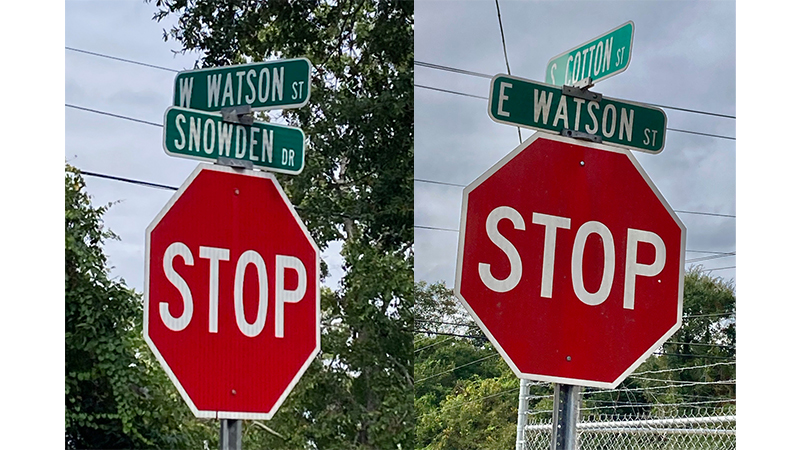A frame map drawn of the city of Andalusia dating back to 1896 it is on display within my work space. It is described as an “Copy of the original plan that was drawn of Andalusia, Alabama” created by Ezekial Watson. This suggests that prior to that the Montezuma village Montezuma relocated up the hill and onto higher ground The “new location” was planned and sketched out on paper. The caption says “…made following the courthouse’s burned in 1875 and later in 1895.”
Some streets marked on the map are recognized today to be official streets of the city are Cotton Street, Coffee Street, Troy Street, Pear Street as well as Yellow River Street. Street names around and in those in and around the Public Square that probably never were opened, or names that were later altered are Water Street, Saw Mill Street (Church Street), Greenland Street (East Three Notch Street), Conecuh Street (South Three Notch Street), Alley Street, James Street, Pigeon Creek Street, Stanley Street, and King Street.
This is similar to today’s subdivisions which are typically drawn on paper, with streets that were designed but never completed or made accessible. It’s like that of the Meadowbrook Subdivision.
While looking for information in old newspapers, I came across this death notice of John Alvin Watson II, the former director and owner of Andalusia Iron Works who passed in 1957, aged 68.
The Andalusia Star News reportedthat “A born in Andalusia Watson, Mr. Watson was the grandson of deceased Ezekial Watson who was awarded an official grant of land to create the country’s first post office on the spot in the area where Wallace’s Store is now. (That is where you will find the current Ward and Company located on the Court Square. )”
“The Watson family was preceded in Andalusia only by the Prestwood family. Ezekial Watson gave the property to The City Square, the Court House and The Baptist Church and Cemetery, and also a school site along Brewton Highway.” Brewton highway.”
“As as a young man, John A. Watson was raised at his Watson farm close to Watson’s Ferry Crossing. He once owned for a number of years an ironsmithing shop which was situated next to J. W. Shreve and Sons (on North Cotton Street).”
“Subsequently, Watson moved with his family to Evergreen for a period of time, where he managed his own business, the Evergreen Bus Works before returning to Andalusia to run his Andalusia iron works (around 1950). Watson sold his business a few years ago M. L. Moore when his declining health forced him to retire.”
A editorial at the time mentions and I quote ” The death of Mr. J. A. Watson, one of Andalusia’s loved citizens brought to light some ancient history. Mr. Watson’s father, J. A. Watson, who was the first J. A. Watson, formerly operated a ferry from the Conecuh River crossing between Andalusia and Brooklyn. There is a bridge is still in place now, but the old timers continue to refer to the site to be Watson’s Ferry Landing.”
Do you know any old timers who still remember the ferry?
The burial of the late Mr. J. A. Watson was in the Andalusia Memorial Park Cemetery. Masonic rituals were conducted near the burial site. It was 1957.. When I looked through the Magnolia Cemetery Index book I didn’t see the name of J. A. Watson’s father, Ezekial Watson, which I had hoped for. It would be helpful to find out the location where that Andalusia early pioneer is buried. Perhaps on the Conecuh River Baptist Church Cemetery? It would be nice to visit his grave and lay flowers in honor of his vision and generosity. Wouldn’t he like to know that his contribution during the mid 1800s did not just affect South Alabama’ growth but also helped to flourish lives within the economic, civic and personal, religious,and social circles?
Three Notch Museum Three Notch Museum is displayed some of the artifacts, mostly agricultural tools (maybe even the lid of an outhouse) and Andalusia Iron Works stamped in the iron. We now know a of Andalusia’s story. Perhaps we can figure out for sure if this is the place where we’re Watson Streets, East and West were named. It’s interesting and instructive to find out more about how our city came to its beginnings, developed, and developed and is fascinating in the same way to keep in mind the times of our past.
Sue Bass Wilson, AHS Class of 1965, was an ex-choral music instructor as well as a local real estate agent, and a for many years a participant in the Covington Historical Society. She can be reached at [email protected].
The article Recall When The history of public space was originally published in The Andalusia Star-News.


